The crisis after 9/11 forced every branch of the military to reevaluate its mission set, its structure, and its identity. Fifteen years later, the process is ongoing. Last week, a congressional report highlighted the debate over whether it should be enlarged or reduced from its current 475,000 soldiers. In that same time, U.S. Special Operations Forces (SOF) grew from a few thousand to 70,000 today. The Air Force expanded its corps of drone pilots and still seeks to double its current number. The changes are far reaching, and the sum total is a military that has demonstrated its plasticity in Afghanistan and Iraq while remaining prepared for its traditional role in conventional warfare.
Among the military branches, the Army may have undergone the greatest structural changes, and this allowed it to successfully approach the new challenges of the wars in Afghanistan and Iraq. Lieutenant General (Ret.) Guy Swan told The Cipher Brief that “…one of the most significant changes since 9/11 was moving to a brigade-centric force structure.” The larger division-centric structure was designed with conventional warfare in mind, and by making each brigade more logistically and operationally self-sufficient, the Army could engage missions with more agility than in previous years.
Large structural changes required vast experience and cooperation to put into effect. This was something the Army had no shortage of as Swan went on to say, “[The Army] has taken its experiences in Iraq, Afghanistan, the Horn of Africa, and elsewhere and combined them with its conventional high intensity capabilities to create a much more capable force than could have ever been imagined before 9/11.” This rings true for all of the services who have fought together in conflicts worldwide with an unprecedented level of cooperation and professionalism.
The growth of SOF, in size and in mission set, is an example of how cooperation improved throughout the services. A force that includes specialized combat and reconnaissance personnel from the Army, Navy, Air Force, and Marine Corps, SOF has evolved markedly since 9/11. Lieutenant General (Ret.) Charles Cleveland and Colonel (Ret.) David Maxwell, both SOF veterans, explained this new role to The Cipher Brief: “What emerged after 9-11 was a special operations Surgical Strike capability that combined exquisite intelligence, surveillance, and reconnaissance (ISR) capabilities with precision strikes from unmanned aerial systems and the unparalleled special operations ground and maritime capability to capture or kill high value targets at the time and place of our choosing…” Such operations could not be undertaken without each service functioning at a high level of excellence in concert with one another.
Many recognize that this pivot towards smaller, more agile operations has come at the expense of some traditional and vital roles for our nation’s military. Preparedness for large scale operations against near-peer adversaries remain an important part of the military’s identity and the nation’s defense. Swan remains confident that the U.S. military will be ready: “The Army’s experience over the post-9/11 period has been striking. First of all, America’s Army is now battle tested, tough, and much more aware of the world it operates in.” This final point may be the most important. The landscape of potential conflicts is more varied than ever before.
The U.S. military has proven its resilience and adaptability in equal measure in facing new adversaries in new conflicts. Yet challenges off the battlefield remain. Budgetary constraints and expensive acquisitions projects hinder innovation at a time when the military and the next administration must reexamine the missions of the future. Caring for the armed forces once they return from combat zones challenges the services and leaders who send them into theater. The missions and shape of the force have changed since 9/11. The key to navigating these uncertain times will be the officers and enlisted men and women who carry with them their invaluable wisdom from the last fifteen years.
Will Edwards is an international producer at The Cipher Brief.











